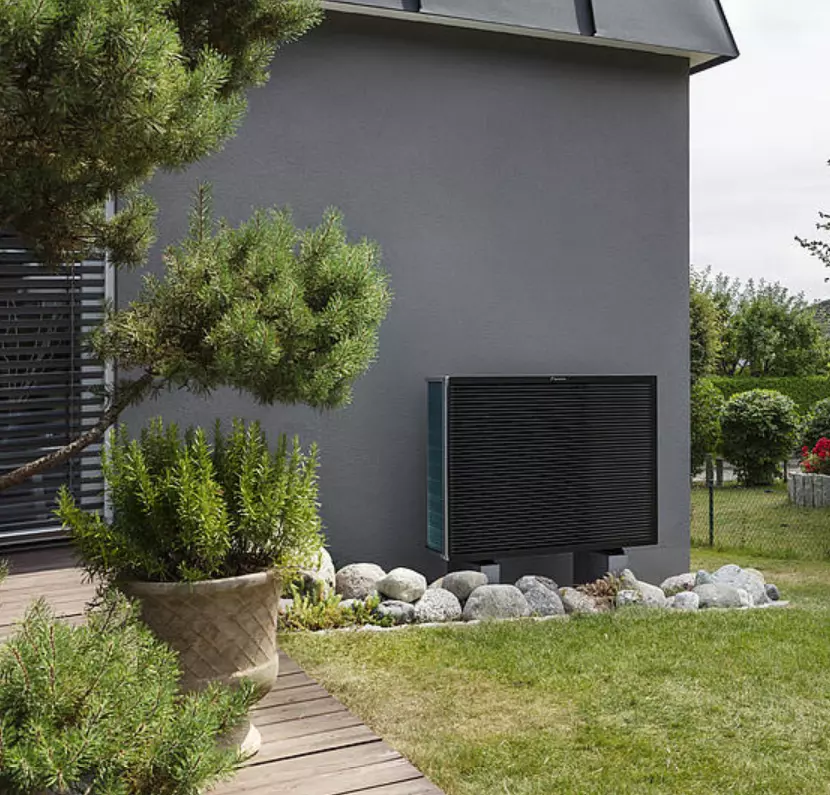
Standard installation includes:
- installation of an air source heat pump up to 2.5 m high (indoor and outdoor)
- sometimes higher, but then consultation is required
- pipeline between indoor and outdoor unit up to 5m
- cable between indoor and outdoor unit up to 5m
- condensate hose between indoor and outdoor unit up to 5m
- running the power cable up to 2m from the indoor or outdoor unit.
- cover box up to 2m
- opening cover for the box 1 pc
- hose 0.5m 1 pc
- rubber bushings 4 pcs
- drilling a hole in the external wall up to 50cm
- wall frame 1 pc
- training on the use and maintenance of the device
For an additional fee:
- electrical work
- use of a forklift on site
- ground frame and base plate
- condensate pump
- additional piping, cable, condensate hose, box, etc.
- refrigerant addition
- diamond drilling

Standard installation includes:
- Connecting the device to the water, heating and freon pipelines (5m) with installation materials.
- Standard installation always includes:
-
- shut-off valves, air separators, mud filters, heating system pressure gauge,
-
- expansion tanks for heating and domestic water, system filling and draining valves,
- pipeline marking,
- covering the freon pipeline with a box outdoors up to 2m,
- drilling a hole in the wall (up to 50 cm thick), except reinforced concrete, earthenware, stone, red brick, etc. (upon agreement for an additional fee),
-
- system start-up and configuration and customer training.
-
- Standard installation always includes:
Preliminary work by the customer before installing the air-to-water heat pump:
- To make the electrical connection, a properly grounded cable must be brought either to the OUTDOOR PART of the heat pump with a margin of 2m or to the INDOOR PART with a margin (pipe length) TO THE OUTDOOR PART (the cross-section of the wire depends on the heat pump model)
- The electrical panel must have a circuit breaker corresponding to the heat pump model and the power cable connected under the fuse in the panel. Specify the fuse size according to the heat pump model;
- The circuit breaker must be routed past the building’s residual current device.
- In the case of additional circulation pumps, bring a separate power supply to each pump directly from the panel;
- To connect the online module, bring a cable with a CAT5/CAT6 connector to the heat pump with a margin of at least 2m.
For an additional fee (if necessary, price by agreement):
- making extracts for the existing system
- installing a circuit breaker in the electrical panel
- power cable and its installation
- drinking water sensor
- insulating the heating and drinking water pipelines
- heating circuit and drinking water circulation pump
- project documentation and implementation drawings
- the installer will determine the need and cost of additional materials in cooperation with the customer
- connecting the device to the WiFi network.

How a geothermal heat pump works?
Ground collector circuit (1)
1) A frost-resistant liquid (ground collector liquid) circulates in a pipe (ground collector) from the heat pump to the heat source (ground/soil/lake). To use the energy from the heat source, the ground collector liquid warms up by a few degrees, from a temperature of about -3 °C to a temperature of 0 °C.
2) The ground collector liquid moves to the heat pump evaporator. Here, the ground collector liquid releases its thermal energy and its temperature drops a few degrees. The liquid then moves back to the heat source to acquire new energy.
Refrigerant circuit (2)
3) Another liquid circulates in the closed system of the heat pump – the refrigerant, which also passes through the evaporator. The refrigerant is characterized by a very low boiling point. In the evaporator, the refrigerant absorbs thermal energy from the ground collector liquid and boils.
4) The steam produced during boiling is fed to the compressor, where the pressure increases as the steam is compressed and the temperature of the steam rises significantly from a temperature of about 5°C to a temperature of about 100°C.
5) From the compressor, the steam is pressed further into a heat exchanger – a condenser, where the heat energy is released into the house’s heating system. The steam is then cooled and condensed back into a liquid state.
6) Since the pressure is still high, the refrigerant passes through an expansion valve, where the pressure drops and the refrigerant’s original low temperature is restored. The refrigerant has now completed a full cycle and is fed back into the evaporator, where the whole process starts over again.
Heating circuit (3)
7) The heat energy that the refrigerant has released in the condenser is now acquired by the boiler part of the heat pump.
8) The heating water circulating in the closed system transfers the heat energy of the heated water to the house’s domestic hot water boiler and radiators/underfloor heating.
There are several stages to installing a ground source heat pump. Usually, a ground collector is first installed in the ground, which takes 1-3 working days. Then the heat pump is installed and then the heat pump is connected to the ground collector. In the final stage, the ground collector is filled with coolant and the heating system with heating water or heat carrier. Finally, the electrical connections are made, the heat pump is set up and the system is checked for operation.

